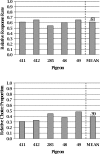The effect of conditioned reinforcement rate on choice: a review
- PMID: 17575906
- PMCID: PMC1868584
- DOI: 10.1901/jeab.2007.44-06
The effect of conditioned reinforcement rate on choice: a review
Abstract
We review the nature of conditioned reinforcement, including evidence that conditioned reinforcers maintain choice behavior in concurrent schedules and that they elevate responding in the terminal links of concurrent-chains schedules. A question has resurfaced recently: Do theories of choice in concurrent-chains schedules need to include a term reflecting greater preference for higher rates of conditioned reinforcement? The review of several studies addressing this point suggests that such a term is inappropriate. Elevated rates of conditioned reinforcement (and responding) in the terminal links of concurrent-chains schedules do not lead to greater preference in the initial link leading to the higher rate of conditioned reinforcement. If anything, the opposite preference is likely to occur. This result is not surprising, since the additional putative conditioned reinforcers in the terminal link are not correlated with a reduction in time to primary reinforcement nor with an increase in value.
Figures



References
-
- Autor S.M. The strength of conditioned reinforcers as a function of frequency and probability of reinforcement. In: Hendry D, editor. Conditioned reinforcement. Homewood, IL: Dorsey Press; 1969. pp. 127–162.
-
- Dinsmoor J.A. Observing and conditioned reinforcement. Behavioral and Brain Sciences. 1983;6:693–728.
-
- Fantino E. Conditioned reinforcement: Choice and information. In: Hendry D, editor. Conditioned reinforcement. Homewood, IL: Dorsey Press; 1969a. pp. 313–339.
Publication types
MeSH terms
Grants and funding
LinkOut - more resources
Full Text Sources

